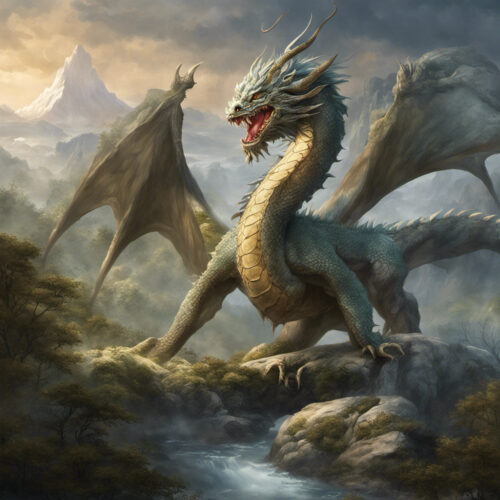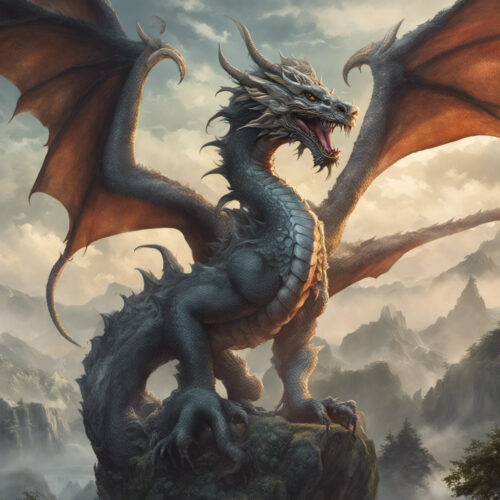Dragons have been a prominent figure in mythology and folklore across cultures for centuries. Among the different types of dragons, the Eastern Dragon stands out as a majestic and awe-inspiring creature. Its depiction in various artworks throughout history has captivated the imaginations of people worldwide. In this article, we embark on a journey exploring the mesmerizing world of Eastern Dragon art and the legends that surround it.
The Origin of Eastern Dragon Art
The origins of Eastern Dragon art can be traced back to ancient China, where it played a significant role in cultural traditions and beliefs. The depiction of Eastern Dragons can be found in various forms of art, including paintings, sculptures, and even architecture. These magnificent creatures were often associated with power, wisdom, and good fortune.
One of the key distinguishing features of Eastern Dragon art is its long, serpentine body. Unlike their Western counterparts, Eastern Dragons are portrayed without wings. Instead, they are believed to possess the ability to fly through the mystical power of their energy, known as “Chi” in Chinese culture.
The intricate brushwork and attention to detail in Eastern Dragon art reflect the deep spiritual significance these creatures hold. Artists aim to capture their essence and convey a sense of dynamism, energy, and vitality. Each brushstroke is deliberate and carries symbolic meaning.
Fascinating Symbolism in Eastern Dragon Art
Eastern Dragon art is rich in symbolism, often representing various aspects of life and spirituality. The Dragon’s association with water represents abundance, renewal, and fertility. It is a potent symbol of rain and the power to control weather phenomena.
The Dragon’s scales, often depicted as fish-like, symbolize its close connection to water and the aquatic realm. In Chinese mythology, the Dragon is known as the master of lakes, rivers, and oceans, embodying the raw power and unpredictability of water.
In Eastern Dragon art, colors play a significant role in conveying meaning. The color red symbolizes good fortune, happiness, and righteousness, while gold represents wealth, power, and prosperity. Blue is associated with the element of water and the Dragon’s connection to the celestial realm.
Furthermore, the Dragon’s five claws hold great symbolic significance. These claws were historically reserved for the Emperor, symbolizing imperial supremacy and divine power. Depictions of Dragons with five claws were a reflection of their association with nobility, royalty, and high status.
Ancient Legends and Tales
The legends and tales surrounding Eastern Dragons are as enchanting as the art itself. One of the most renowned stories is the legend of the Dragon Gate. It is believed that if a carp successfully swims upstream and jumps over the Dragon Gate, it transforms into a powerful Dragon. This story symbolizes perseverance, ambition, and the rewards that come with overcoming obstacles.
Another popular legend is the story of the Dragon Pearl. It is said that Dragons possessed a precious pearl, representing wisdom, enlightenment, and spiritual clarity. Anyone who obtained this pearl was believed to gain immense knowledge, power, and good fortune.
Eastern Dragon art also showcases mythical tales of Dragons interacting with other legendary creatures like Phoenixes, Tigers, and Lions. These depictions symbolize harmony, balance, and the cosmic forces at play in the universe.
The Influence of Eastern Dragon Art Today
Eastern Dragon art continues to captivate contemporary artists and enthusiasts worldwide. Its influence can be seen in various forms, from traditional paintings to modern digital art. The allure of these magnificent creatures stands the test of time and remains a source of inspiration for many.
As we explore the realms of Eastern Dragon art, we find ourselves immersed in a world full of symbolism, ancient legends, and rich cultural heritage. It is a journey that sweeps us away on the wings of imagination and reminds us of the eternal fascination humanity has had with these majestic creatures.
Conclusion
The art of Eastern Dragons is a testament to the profound impact these creatures have had on human imagination and creativity. Their representation in various forms of artwork has allowed us to delve into the realms of mythology, spirituality, and symbolism. As we continue to appreciate and explore Eastern Dragon art, we keep the ancient legends alive and carry their magic with us through the passage of time.



